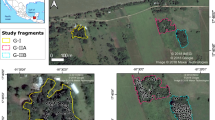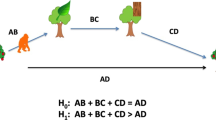Abstract
Food patch visitation was compared to the availability of fruit patches of different species during 2 years in a Bornean lowland forest to examine orangutan (Pongo pygmaeus) diet selectivity. Feeding on both the pulp and the seeds of nonfig fruit varied directly with fruit patch availability, demonstrating preference for these foods over fig fruit or other plant parts (bark or leaves). Factors determining fruit selectivity rank were examined through multiple regression analysis. Modeling selectivity for 52 chemically unprotected “primate-fruit” pulp species revealed strong preferences for species of (i) large crop size (numbers of fruits ripening in an individual patch), (ii) high pulp weight/fruit, and (iii) high pulp mass per swallowed unit of pulp + seed, demonstrating orangutan sensitivity especially to patch size (g of pulp or total energy/patch) and perhaps to fruit handling time. Modeling selectivity for 18 fig species showed that 4 factors significantly influenced fig species rank: crop size, pulp weight/fruit, and 2 chemical variables, percentage digestible carbohydrate and percentage phenolic compounds in the fig fruit pulp. The selectivity rank based on the overall nutrient gain from feeding in the fruit patch (the product of the first 3 variables) is proportionally depressed by the percentage tannin content, demonstrating that orangutans integrate values for these variables in selecting fig patches. The conclusions from these results and from analysis of selectivity for seeds and for other fruit types are that orangutan foraging decisions are strongly influenced by the meal size expected from a feeding visit (i.e., by patch size), that tannins and other toxins deter feeding, and that the energy content, rather than the protein content, of foods is important in diet selection. The foraging strategy of orangutans is interpreted relative to these results and to Bornean fruiting phenology. By integrating spatial, morphometric, and chemical variables in analysis, this study is the first to demonstrate the application of foraging theory to separate out the key variables that determine diet selection in a primate. Multivariate analysis should routinely be applied to such data to distinguish among the many covarying attributes of food items and patches; inferences drawn in previous studies of primate diet selection, which ignore key spatial and morphological variables and rely on univariate correlations, are therefore suspect.
Similar content being viewed by others
References
Calder, W. A., III (1984).Size, Function and Life History, Harvard University Press, Cambridge, MA.
Charnov, E. L. (1976). Optimal foraging: The marginal value theorem.Theor. Pop. Biol. 9: 129–136.
Chesson, J. (1978). Measuring preference in selective predation.Ecology 59: 211–215.
Chesson, J. (1983). The estimation and analysis of preference and its relationship to foraging models.Ecology 64: 1297–1304.
Clutton-Brock, T. H., and Harvey, P. H. (1984). Comparative approaches to investigating adaptation. In Krebs, J. R., and Davies, N. B. (eds.),Behavioural Ecology: An Evolutionary Approach, 2nd ed., Sinauer Associates, Sunderland, MA, pp. 7–29.
Cock, M. J. W. (1978). The assessment of preference.J. Anim. Ecol. 47: 805–816.
Conover, W. J. (1980).Practical Nonparametric Statistics, 2nd ed., John Wiley & Sons, New York.
Davies, A. G., Bennett, E. L., and Waterman, P. G. (1988). Food selection by two South-east Asian colobine monkeys (Presbytis rubicunda andPresbytis melalophus) in relation to plant chemistry.Biol. J. Linn. Soc. 34: 33–56.
Demment, M. W., and Van Soest, P. J. (1985). A nutritional explanation for body-size patterns of ruminant and nonruminant herbivores.Am. Nat. 125: 641–672.
Freeland, W. J., and Janzen, D. H. (1974). Strategies of herbivory in mammals: The role of plant secondary compounds.Am. Nat. 108: 269–289.
Galdikas, B. M. F. (1978). Orangutan diet, range, and activity at Tanjung Puting, Central Borneo.Int. J. Primatol. 9: 1–36.
Glander, K. E. (1982). The impact of plant secondary compounds on primate feeding behavior.Yearbk. Phys. Anthropol. 25: 1–18.
Herrera, C. M. (1982). Defense of ripe fruit from pests: its significance in relation to plant-disperser interactions.Am. Nat. 120: 218–241.
Howe, H. F., and Vande Kerckhove, G. A. (1980). Nutmeg dispersal by tropical birds.Science 210: 925–927.
Janson, C., Stiles, E. W., and White, D. W. (1986). Selection on plant fruiting traits by brown capuchin monkeys: A multivariate approach. In Estrada, A., and Fleming, T. H. (eds.),Frugivores and Seed Dispersal, Dr. W. Junk, Dordrecht, pp. 83–92.
Johnson, D. H. (1980). The comparison of usage and availability measurements for evaluating resource preference.Ecology 61: 65–71.
Krebs, J. R., and Stephens, D. W. (1986).Foraging Theory, Princeton University Press, Princeton, NJ.
Leighton, M. (1982).Fruit Resources and Patterns of Feeding, Spacing and Grouping Among Sympatric Bornean hornbills (Bucerotidae), Doctoral dissertation, University of California, Davis (University Microfilms, Ann Arbor, MI).
Leighton, M. (1992). Patterns of demography and habitat selection among sympatricFicus species in Kutai, East Kalimantan (Borneo), and their implications for species coexistence (in preparation).
Leighton, M., and Leighton, D. R. (1982). The relationship of size of feeding aggregate to size of food patch: Howler monkeys (Alouatta palliata) feeding inTrichilia cipo fruit trees on Barro Colorado Island.Biotropica 14: 81–90.
Leighton, M., and Leighton, D. R. (1983). Vertebrate responses to fruiting seasonality within a Bornean rain forest. In Sutton, S. L., Whitmore, T. C., and Chadwick, A. C. (eds.),Tropical Rain Forest: Ecology and Resource Management; Blackwell Scientific, Oxford, pp. 181–196.
Leighton, M., and Wirawan, N. (1986). Catastrophic drought and fire in Bornean tropical rain forest associated with the 1982–83 ENSO event. In Prance, G. (ed.),Tropical Rain Forests and the World Atmosphere, Westview Press, Boulder, CO, pp. 75–102.
Lloyd, L. E., McDonald, B. E., and Crampton, E. W. (1978).Fundamentals of Nutrition, 2nd ed., W. H. Freeman, New York.
MacArthur, R. H., and Pianka, E. R. (1966). On optimal use of a patchy environment.Am. Nat. 100: 603–609.
MacKinnon, J. R. (1974). The behaviour and ecology of wild orang-utans (Pongo pygmaeus).Anim. Behav. 22: 3–74.
Marks, D. L., Swain, T., Goldstein, S., Richard, A., and Leighton, M. (1988). Chemical correlates of rhesus monkey food choice: The influence of hydrolyzable tannins and free amino acids.J. Chem. Ecol. 14: 213–235.
Martin, T. E. (1985). Resource selection by tropical frugivorous birds: Integrating multiple interactions.Oecologia 66: 563–573.
McKey, D. B., Gartlan, S. J., Waterman, P. G., and Choo, G. M. (1981). Food selection by black colobus monkeys (Colobus satanus) in relation to plant chemistry.Biol J. Linn. Soc. 16: 115–146.
Milton, K. (1979). Factors affecting leaf choice by howler monkeys: A test of some hypotheses of food selection by generalist herbivores.Am. Nat. 114: 362–377.
Milton, K. (1984). The role of food-processing factors in primate food choice. In Rodman, P. S., and Cant, J. G. H. (eds.),Adaptations for Foraging in Nonhuman Primates, Columbia University Press, New York, pp. 249–279.
Mitani, J. C. (1985). Mating behaviour of male orangutans in the Kutai Game Reserve, Indonesia.Anim. Behav. 33: 391–402.
Moermond, T. C., and Denslow, J. S. (1985) Neotropical avian frugivores: Patters of behavior, morphology and nutrition, with consequences for fruit selection. In Buckley, P. A., Foster, M. S., Morton, E. S., Ridgley, R. S., and Buckley, F. G. (eds.),Neotropical Ornithology, Ornithol. Monogr. No. 36, Am. Ornithol. Union, Washington, DC, pp. 865–897.
Mole, S., and Waterman, P. G. (1987). A critical analysis of techniques for measuring tannins in ecological studies. I. Techniques for chemically defining tannins.Oecologia 72: 137–147.
Richard, A. F. (1985).Primates in Nature, W. H. Freeman, New York.
Rijksen, H. D. (1978).A Field Study on Sumatran Orang-utans (Pongo pygmaeus abeliiLesson 1827): Ecology, Behaviour and Conservation, H. Veenman and Zonen, Wageningen.
Robbins, C. T. (1983).Wildlife Feeding and Nutrition, Academic Press, New York.
Rodman, P. S. (1977). Feeding behavior of orangutans in the Kutai Reserve, East Kalimantan. In Clutton-Brock, T. H. (ed.),Primate Ecology, Academic Press, London, pp. 383–413.
Rodman, P. S. (1984). Foraging and social systems of orangutans and chimpanzees. In Rodman, P. S. and Cant, J. G. H. (eds.),Adaptations for Foraging in Nonhuman Primates, Columbia University Press, New York, pp. 134–160.
Rodman, P. S. (1988). Diversity and consistency in ecology and behavior. In Schwartz, J. H. (ed.),Orang-utan Biology, Oxford University Press, pp. 31–51.
Rodman, P. S., and Mitani, J. C. (1987). Orangutans: Sexual dimorphism in a solitary species. In Smuts, B., Cheny, D. L., Seyfarth, R. M., Sturhsaker, T., and Wrangham, R. W. (eds.),Primate Societies, University of Chicago Press, Chicago, pp. 146–154.
Rogers, E. M., Maisels, F., Williamson, E. A., Fernandez, M., and Tutin, C. E. G. (1990). Gorilla diet in the Lope Reserve, Gabon: A nutritional analysis.Oecologia 84: 326–339.
Schluter, D. (1982). Seed and patch selection by Galapagos ground finches: Relation to foraging efficiency and food supply.Ecology 63: 1108–1120.
Schurmann, C. L., and van Hooff, J. A. R. A. M. (1986). Reproductive strategies of the orang-utan: New data and a reconsideration of existing sociosexual models.Int. J. Primatol. 7: 265–287.
Smallwood, P. D., and Peters, W. D. (1986). Grey squirrel food preferences: The effects of tannin and fat concentration.Ecology 67: 168–174.
Sugardijto, J. (1982). Locomotor behaviour of the Sumatran orang utan (Pongo pygmaeus abelii) at Ketembe, Genung Leuser National Park.Malay. Nat. J. 35: 57–64.
Sugardjito, J., te Boekhorst, I. J. A., and van Hooff, J. A. R. A. M. (1987). Ecological constraints on the grouping of wild orang-utans (Pongo pygmaeus) in the Gunung Leuser National Park, Sumatera, Indonesia.Int. J. Primatol. 8: 17–41.
te Boekhorst, I. J. A., Schurmann, C. L., and Sugardjito, J. (1990). Residential status and seasonal movements of wild orang-utans in the Gunung Leuser Reserve (Sumatera, Indonesia).Anim. Behav. 39: 1098–1109.
Van Soest, P. J. (1981).Nutritional Ecology of the Ruminant, O & B Books, Corvallis, OR.
Waterman, P. G., and Choo, G. M. (1981). The effects of digestibility-reducing compounds in leaves on food selection by some colobinae.Malays. Appl. Biol.10: 147–162.
Westoby, M. (1974). An analysis of diet selection by large generalist herbivores.Am. Nat. 108: 290–304.
Wheatley, B. P. (1982). Energetics and foraging inMacaca fascicularis andPongo pygmaeus and a selective advantage of large body size in the orang-utan.Primates 23: 348–363.
Wilkinson, L. (1989).SYSTAT: The System for Statistics, SYSTAT, Evanston, IL.
Wrangham, R. W., and Waterman, P. G. (1983). Condensed tannins in fruits eaten by chimpanzees.Biotropica 15: 217–222.
Author information
Authors and Affiliations
Rights and permissions
About this article
Cite this article
Leighton, M. Modeling dietary selectivity by Bornean orangutans: Evidence for integration of multiple criteria in fruit selection. International Journal of Primatology 14, 257–313 (1993). https://doi.org/10.1007/BF02192635
Received:
Accepted:
Issue Date:
DOI: https://doi.org/10.1007/BF02192635




